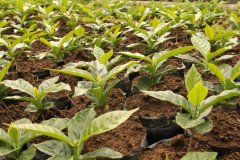West Damogu Ji-Mokanisha Processing Plant Introduction Ethiopia Administrative Division and Green Bean Naming Rules
The Sidamo producing area (Sidama) is located in southern Ethiopia. The industry here is dominated by agriculture, and the coffee-growing area is located around the East African Great Rift Valley (Great Rift Valley).

The coffee in Sidamo has a variety of flavors. Different soil types, microclimates and countless native coffee species, towering mountains, highlands, plateaus, valleys and plains, diverse topography, and the geology of the area belongs to nutrient-rich, well-drained volcanic soil. the depth of the soil is nearly two meters, and the surface soil is dark brown or brown. The biggest advantage of the area is that the soil fertility is maintained through the circulation of organic matter, using the withered leaves of the surrounding trees or the residual roots of the plants as fertilizer. Therefore, the coffee produced in cities and towns has obvious differences and characteristics.

Taste analysis: apricot full and sweet, soft floral notes, juicy and rich taste, sucrose sweetness in the end
The production area of Guji Zone has always been a production area worthy of considerable attention, and the development in recent years has also confirmed that the rise of Guji production area is indeed one of the important trends in the development of Ethiopia in recent years. In addition to the beans from the larger producing areas, such as Humbera and Shakespeare, there are also excellent beans from processing plants or even single estates, which are unmatched by the traditional Yega Sheffield producing areas. What's more, in terms of innovative treatment methods, there will also be honey treatment batches. In addition to the recent focus in Gesha Village, the Guji producing area has also become an important hot spot. To understand the trends in Ethiopia, Guji can be said to be a key point that can not be ignored.
The administrative region of Ethiopia is divided into four grades, the order from big to small is Region, Zone, woreda and kebele. Most of the names of raw coffee beans follow this rule. Guji-Shaquiso, which is located in the southeast of Yejia Sheffield, a well-known producing area, belongs to Oromia Region → Guji Zone → Shakisso woreda, belonging to the regional source of coffee beans.
Important Notice :
前街咖啡 FrontStreet Coffee has moved to new addredd:
FrontStreet Coffee Address: 315,Donghua East Road,GuangZhou
Tel:020 38364473
- Prev

Introduction to the Cup Test of FINCA LINA Fern Kaarina Manor in Caldas, Colombia
Country: Columbia Manor: FINCA LINA Finn Kaarina production area: Caldas Variety: Kaddura treatment: washing Cup Test report: Colombia is currently the second largest Arabica coffee producer in the world, producing coffee from beginning to end because of the climate, which is a good thing for consumers, but not a good thing for hard-working farmers.
- Next

Introduction to the Climatic advantages of the planting situation of the Yilida Manor in Panama
For the exchange of professional baristas, please pay attention to the coffee workshop (Wechat official account cafe_style) Ilida Manor, located in Alto Quiel, Baru Volcano district of Boquete, is one of the world-renowned coffee farms and is often at the top of the Panama bidding competition. The Yilda Manor is shrouded in clouds during the dry season, which is called horizontal precipitation.
Related
- Does Rose Summer choose Blue, Green or Red? Detailed explanation of Rose Summer Coffee plots and Classification in Panamanian Jade Manor
- What is the difference between the origin, producing area, processing plant, cooperative and manor of coffee beans?
- How fine does the espresso powder fit? how to grind the espresso?
- Sca coffee roasting degree color card coffee roasting degree 8 roasting color values what do you mean?
- The practice of lattes: how to make lattes at home
- Introduction to Indonesian Fine Coffee beans-- Java Coffee producing area of Indonesian Arabica Coffee
- How much will the flavor of light and medium roasted rose summer be expressed? What baking level is rose summer suitable for?
- Introduction to the characteristics of washing, sun-drying or wet-planing coffee commonly used in Mantenin, Indonesia
- Price characteristics of Arabica Coffee Bean Starbucks introduction to Manning Coffee Bean Taste producing area Variety Manor
- What is the authentic Yega flavor? What are the flavor characteristics of the really excellent Yejasuffi coffee beans?

